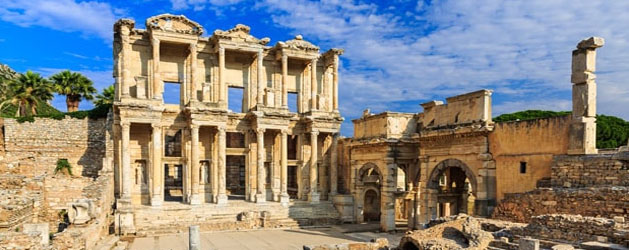(PAT-01) Patmos – St John's Monastery & Grotto of Apocalypse (Approx. 2hrs.)
The picturesque alleyways wind upwards, towards the Monastery of St. John the Evangelist, which was founded in 1088 by St. Christodoulos. The visit will open the doors of the Monastery’s yard (the place where the monks take their meals) and the old bakery. Of exquisite beauty is the tour of the Byzantine Church of St. John. It is adorned with a wood-carved icon screen, important frescoes from several periods, and both mosaic and other icons. The next stop is the small museum which hosts religious treasures, like manuscripts, medieval textiles, sacerdotal vestments and others. Walking down the stairs, the religious energy that you will experience is soul touching. Behind the chapel of St. Anne lies the entrance to the Grotto of the Apocalypse. You will see the cross engraved by St. John the Evangelist. According to tradition, the triple fissure in the wall of the cave is from where St. John heard God dictating to him the Apocalypse, along with the spot where he lay down to sleep.
PLEASE NOTE: Tour not suitable for passengers with walking difficulties. Includes visit to religious sites (knees and shoulders must be covered). Port of Scala free time will depend on overall shore excursion volume.
(HER-02) Heraklion of Crete – Minoan Palace of Knossos (Approx. 3hrs.)
The ancient city of Knossos, with constant habitation from the Neolithic era until the 5th century A.D., is beyond doubt the land that “gave birth” to the first civilization of Europe, the Minoans. The first excavations were begun in 1878 by the Heraklian Minos Kalokairinos. A bit later (1900-1913 & 1922-1930) the excavations by the British Sir Arthur Evans were to complete the scientific research. This brought to light the Minoan palace in its entirety, which, according to tradition, was the residence of the wise King Minos. The palace of Knossos spreads around the large Central Court. You will reach the awe inspiring Throne Room, the fresco of the “Prince of the Lilies,” the imposing Grand Staircase, and the Queen’s Megaron in the east. Walking through the apartments of the Knossos palace and observing the finds (even as passers-by) will make you feel part of this cultural heritage.
PLEASE NOTE: Walking in the archaeological site of Knossos will be on uneven gravel surfaces. Passengers may not be allowed to enter the site with big bags/rucksacks.
(SAN-01) Santorini – Spectacular Oia Village perched on the caldera rim (Approx. 3hrs.)
First you head up to Megalochori village, one of the most authentic and unspoiled villages of the island with its distinctive architecture and character. We will continue on to the east, in the background, you will have settlements like Kamari and Monolithos, while you will pass through Fira, the small traditional villages of Firostefani and Imerovigli with delicate architecture and beauties, to eventually arrive at the settlement of Oia. During the entire route, to the west you will have before your eyes the lace-like caldera, the little islands of Thirasia, Palea and Nea Kameni and an unsurpassable panoramic view. In Oia you will have plenty of time to stroll through the marble-paved alleys, to gaze at the adorably cute shops, to take pictures, to become acquainted with the characteristic buildings, carved into the rocks and the unusual captains' manors, the settlement Ammoudi at the foot of the caldera. After your curiosity has been sated of the area which is characterized as being of "exceptional natural beauty", your return begins.
(KUS-02) Ancient Ephesus through the ages (Approx. 3hrs.)
At Ancient Ephesus you find immortal relics of the Hellenistic, Roman and Early Christian era. At the archaeological site you will be given a guided tour among the Agora, the Odeon, the Library of Celsus, the marble-paved main Street of Kouretes, the Baths of Scholastica, Trajan’s Fountain, the Public Latrines, Residences of the Patricians, the Prytaneum, the Temple of Hadrian and the Great Theatre. The Great Theatre, built in the 4th century B.C., could accommodate 24,000 spectators and is famous, even nowadays, for its acoustics. The finds from the excavations, which have yet brought to light only 13% of ancient Ephesus, reside in the Archaeological Museum of Ephesus, in the city of Selcuk. Your day couldn’t close in a better way than a beautiful walk through the Covered Bazaar in Kusadasi. Here, you will be able to ramble, bargain for jewelry, cosmetics or leather products at the little shops. During the excursion you will have the opportunity to do some shopping for items such as carpets, jewelry, leather, and other souvenirs.
PLEASE NOTE: Tour not suitable for passengers with walking difficulties. Includes visit to religious sites (knees and shoulders must be covered). Port of Scala free time will depend on overall shore excursion volume. Ephesus shore excursions are eligible for those embarking from Athens only. All tours that originate in Turkey already include a full day tour of Ephesus.
(PAT-01) Patmos – St John's Monastery & Grotto of Apocalypse (Approx. 2hrs.)
The picturesque alleyways wind upwards, towards the Monastery of St. John the Evangelist, which was founded in 1088 by St. Christodoulos. The visit will open the doors of the Monastery’s yard (the place where the monks take their meals) and the old bakery. Of exquisite beauty is the tour of the Byzantine Church of St. John. It is adorned with a wood-carved icon screen, important frescoes from several periods, and both mosaic and other icons. The next stop is the small museum which hosts religious treasures, like manuscripts, medieval textiles, sacerdotal vestments and others. Walking down the stairs, the religious energy that you will experience is soul touching. Behind the chapel of St. Anne lies the entrance to the Grotto of the Apocalypse. You will see the cross engraved by St. John the Evangelist. According to tradition, the triple fissure in the wall of the cave is from where St. John heard God dictating to him the Apocalypse, along with the spot where he lay down to sleep.
PLEASE NOTE: Tour not suitable for passengers with walking difficulties. Includes visit to religious sites (knees and shoulders must be covered). Port of Scala free time will depend on overall shore excursion volume.
(HER-02) Heraklion of Crete – Minoan Palace of Knossos (Approx. 3hrs.)
The ancient city of Knossos, with constant habitation from the Neolithic era until the 5th century A.D., is beyond doubt the land that “gave birth” to the first civilization of Europe, the Minoans. The first excavations were begun in 1878 by the Heraklian Minos Kalokairinos. A bit later (1900-1913 & 1922-1930) the excavations by the British Sir Arthur Evans were to complete the scientific research. This brought to light the Minoan palace in its entirety, which, according to tradition, was the residence of the wise King Minos. The palace of Knossos spreads around the large Central Court. You will reach the awe inspiring Throne Room, the fresco of the “Prince of the Lilies,” the imposing Grand Staircase, and the Queen’s Megaron in the east. Walking through the apartments of the Knossos palace and observing the finds (even as passers-by) will make you feel part of this cultural heritage.
PLEASE NOTE: Walking in the archaeological site of Knossos will be on uneven gravel surfaces. Passengers may not be allowed to enter the site with big bags/rucksacks.
(SAN-01) Santorini – Spectacular Oia Village perched on the caldera rim (Approx. 3hrs.)
First you head up to Megalochori village, one of the most authentic and unspoiled villages of the island with its distinctive architecture and character. We will continue on to the east, in the background, you will have settlements like Kamari and Monolithos, while you will pass through Fira, the small traditional villages of Firostefani and Imerovigli with delicate architecture and beauties, to eventually arrive at the settlement of Oia. During the entire route, to the west you will have before your eyes the lace-like caldera, the little islands of Thirasia, Palea and Nea Kameni and an unsurpassable panoramic view. In Oia you will have plenty of time to stroll through the marble-paved alleys, to gaze at the adorably cute shops, to take pictures, to become acquainted with the characteristic buildings, carved into the rocks and the unusual captains' manors, the settlement Ammoudi at the foot of the caldera. After your curiosity has been sated of the area which is characterized as being of "exceptional natural beauty", your return begins.


